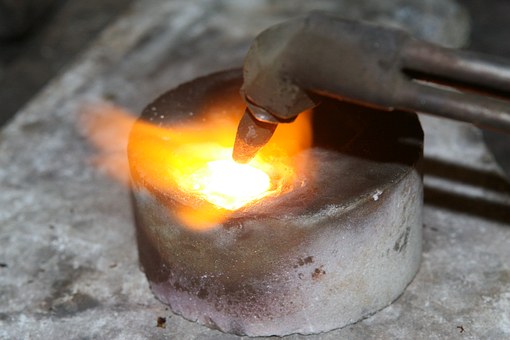This article will discuss whether a melting point is a physical property of matter.
We define a melting point as a specific temperature at which the conversion of solid to liquid is observed. Since this process has something to do with physical aspects and is associated with the physical change of the substance. It can be regarded as a physical property of matter.
In the upcoming sections, you will learn about the detailed facts of how and why the melting point is taken to be a physical property.
Is melting point a physical property?
Melting point is a physical property.
Below you can find a simple explanation for the same, We know that melting is nothing but a process in which a solid melts and gets transformed into a liquid. Here we can observe that the substance changes its physical state of matter while melting, whereas the chemical composition is unchanged.
Read more: Is boiling point a physical property
How is melting point a physical property?
The melting point of a substance is associated with the physical aspects of the matter.
Following are some of the prime reasons because of which the melting point is regarded as a physical property, The solid converts to liquid at a temperature termed the melting point. Since the matter’s chemical identity is not changed during this phenomenon, it can be physical. Therefore, we classify the melting point as a physical property.
Similar to other physical properties of matter such as color, smell, hardness, texture, density, the measurement of melting point is not followed by the alteration of the fundamental nature of the substance.

Is change in melting point a physical property?
Change in melting point is also said to be a physical property.
We already learned that melting point is a physical property since we observe a state change from solid to liquid, but its chemistry remains as it is. Further, it comes back to the solid-state if we cool the liquid. This process shows that a change in the substance’s melting point is also a physical property.
How is a change in melting point a physical property?
Change in melting point is a physical property since a physical change occurs.
Here are the facts that help understand the change in melting point to be a physical property. When there is a change in the melting point, the substance will change, but the molecule remains the same throughout these changes.
Physical changes are related to the physical properties as changes are supposed to be made to perform some measurements.
Read more: Is solubility a physical property
Is a low melting point a physical property?
A low melting point can be a physical property.
Melting points of Metals and non-metals do vary. Regularly, Non-metals are expected to have low melting points. Since the low melting points of non-metals can be used as an identification factor, it is considered a physical property.
Is a high melting point a physical property?
A high melting point is also a physical property.
Melting points can be considered as a differentiating factor between metals and non-metals. All metals around us are said to have melting points. These melting points differ from one metal to another metal. In general, we observe that high melting points are associated with metals.
What are the factors that affect the melting point of a substance?
The melting point depends on various parameters related to that material.
Some of the primary factors that affect the melting point are listed below,
What do you mean by a melting point range?
Melting point range is used to refer to a range of temperatures. In this section, let us now know how “melting point range” is different from “melting point”,
Even though the melting point is defined as a particular temperature at which melting takes place, In real, usually a range of temperatures is identified over which the solid is said to melt but not at one specific temperature. For this reason, it will be more relevant to talk about a “melting point range” in place of a “melting point”.
How the melting point of the substance helps in identifying whether it is pure or impure?
In identifying a material, melting point is helpful as it is a physical property associated with a physical change in the substance.
By determining the melting point of a substance, it is possible to comment on its purity. This concept can be explained as follows, Here we consider the “melting point range” concept rather than a specific “melting point”. A relatively pure compound will melt over a narrow temperature range. At the same time, a compound is considered to be relatively impure if it melts over a wide range of temperatures.
Also, some experiments are performed to show that impure solids melt at a lower point than pure solids.
Frequently asked questions| FAQs
What Is the state of matter at melting point a physical property?
Every property of matter is either a physical or chemical property.
By the definition of the melting point, we can infer that, When a solid matter gets heated, it gradually starts melting and turns into a liquid state.

To which change of matter the melting point is associated?
A property’s connection to any change depends on the type of identity influenced by that property.
By studying the melting process, we can say that melting represents a physical change as the chemical identity of the matter remains unchanged; this is why the melting point is considered the physical property of matter. To measure the flammability (the material’s tendency to ignite) chemical property of matter, we need to burn that substance.
Why do the values of melting points differ from metal to metal?
This theory is due to the dependency of the melting point on different properties of the metals.
Different metals are said to have different values of melting points; the following criterion can explain this, All metals are said to possess some variety of physical and chemical properties; these physical and chemical properties of metals are supposed to be consisting of an intermolecular force of attraction associated with that metal.

Why do we need heat energy to melt a solid?
There is a requirement of energy (in any form) to perform any process, may it be physical or chemical.
The reason why there is the consumption of energy in the form of heat while melting a solid is, To melt a solid, we need to overcome the attractive forces between the molecules and set them free to move faster. For this, the kinetic energy of the particles should increase, which can be done by the supply of thermal energy.
Read more: Kinetic to thermal energy
How can we relate the melting point of a liquid to pressure?
Melting points are seen to be depending upon various factors.
The theory that explains why the melting point of a liquid is influenced by pressure is given as follows, At the melting point, both the liquid and solid phases are said to be existing at equilibrium. The melting point of a substance has a specified value at standard pressure, and it is said to be varying with the pressure.
Is its melting point and freezing point the same for a substance?
Melting and freezing point have identical values.
The melting and freezing points are named so by associating them with the two different states of matter. Can explain it in the following manner, the same two states, i.e., solid and liquid, are involved in the change of state at melting (solid to liquid) and freezing point (liquid to solid). Therefore, both of them are going to have exact values.
Also Read:
Hi…..I am Harshitha H N. I have completed my master’s in Physics from the University of Mysore with a specialization in Nuclear physics. I enjoy exploring new things in my free time. My article always aims to develop and bring some value to the table with relevant topics.
Let’s connect through LinkedIn-